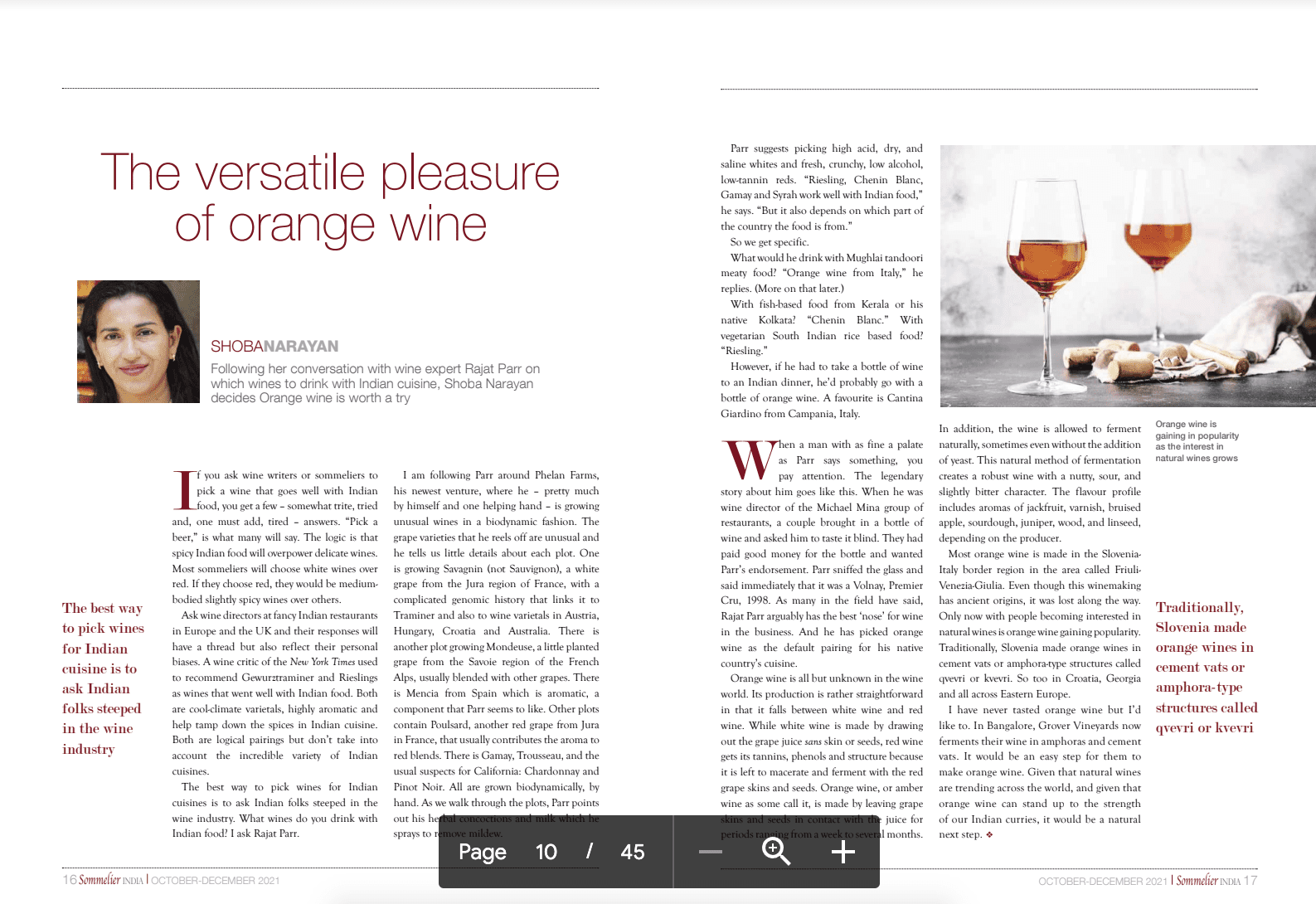The unbridled pleasure of orange wine
If you ask wine writers or sommeliers to pick a wine that goes well with Indian food, you get a few– somewhat trite, tried and, one must add, tired– answers.
“Pick a beer,” is what many will say. The logic is that spicy Indian food will overpower delicate wines. Most sommeliers will choose white wines over red. If they choose red, it would be medium-bodied slightly spicy wines over others.
Ask wine directors at fancy Indian restaurants in Europe and the UK and their responses will have a thread but also reflect their personal biases. A wine critic of the New York Times used to recommend Gewurztraminer and Rieslings as wines that went well with Indian food. Both are cool-climate varietals, highly aromatic and help tamp down the spices in Indian cuisine. Both are logical pairings but don’t take to account the incredible variety of Indian cuisines.
The best way to pick wines for Indian cuisine is to ask Indian folks steeped in the wine industry. What wines do you drink with Indian food, I ask Rajat Parr.

I am following Parr around Phelan Farms, his newest venture, where he– pretty much by himself and one helping hand– is growing unusual wines in a biodynamic fashion. The grape varieties that he reels off are unusual and he tells us little details about each plot. One is growing Savagnin (not sauvignon), a white grape from the Jura region of France, with a complicated genomic history that links it to Traminer but also wine varietals in Austria, Hungary, Croatia and Australia. There is another plot growing Mondeuse, another little planted grape from the Savoie region of the French alps, usually blended with other grapes. There is Mencia from Spain, which also is aromatic– a component that Parr seems to like. Other plots contain Poulsard, another red grape from Jura in France, that usually contributes the aroma to red blends. There is Gamay, Trousseau, and the usual suspects for California: Chardonnay and Pinot Noir. All are grown biodynamically, by hand. As we walk through the plots, Parr points out his herbal concoctions and milk which he sprays to remove mildew.
Parr suggests picking high acid, dry, and saline whites, and fresh, crunchy, low alcohol, low-tannin reds. “Riesling, Chenin Blanc, Gamay and Syrah work well with Indian food,” he says. “But it also depends on which part of the country the food is from.”
So we get specific.
What would he drink with Mughlai tandoor meaty food?”
“Orange wine from Italy,” he replies. More on that later.
With fish-based food from Kerala or his native Kolkata?
“Chenin Blanc.”
With vegetarian South Indian rice based food?
“Riesling.”
If he had to just take a bottle of wine to an Indian dinner, he’d probably go with a bottle of orange wine.
A favourite is Cantina Giardino from Campania, Italy.


When a man with as fine a palate as Parr says something, you pay attention. The legendary story about him goes like this. When he was wine director of the Michael Mina group of restaurants, a couple brought in a bottle of wine and asked him to taste it blind. They had paid good money for the bottle and wanted Parr’s endorsement. Parr sniffed the glass and said that it was a Volnay, Premier Cru, 1998 wine. As many in the field have said, Rajat Parr may have the best ‘nose’ for wine in the business. And he has picked orange wine as a pairing for his native country’s cuisine.
Orange wine is all but unknown in the wine world. Its making is rather straightforward in that it falls between white wine and red wine. While white wine is made by drawing out the grape juice sans skin or seeds, red wine gets its tannins, phenols and structure because it is left to macerate and ferment with the red grape skins and seeds. Orange wine, or amber wine as some call it is made by leaving grape skins and seeds in contact with the juice for a week to several months. In addition, the wine is allowed to ferment naturally, sometimes even without the addition of yeast. This natural method of fermentation creates a robust wine with a nutty, sour, and slightly bitter character. The flavour profile includes aromas of jackfruit, varnish, bruised apple, sourdough, juniper, wood, and linseed– depending on the producer.
Most orange wine is made in the Slovenia-Italy border region in the area called Fruili-Venezia-Guilia. Even though this winemaking has ancient origins, it was lost along the way. Only now with people becoming interested in natural wines is orange wine gaining popularity. Traditionally, Slovenia made orange wines in cement vats or amphora-type structures called qvevri or kvevri. So too in Croatia, Georgia and all across Eastern Europe.
I have never tasted orange wine but I’d like to. In Bangalore, Grover Vineyards now ferments their wine in amphoras and cement vats. It would be an easy step for them to make orange wine. Given that natural wines are trending across the world, and given that orange wine can stand up to the strength of our Indian curries, it would be a natural next step.




Leave A Comment